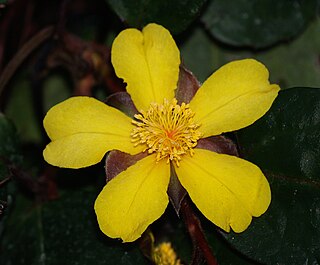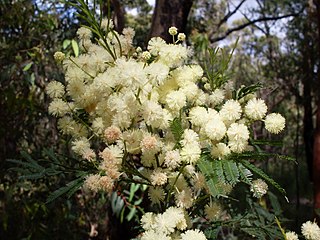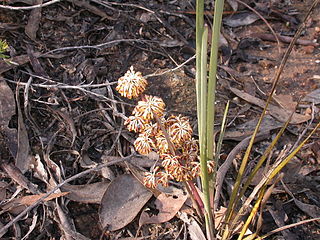
Ranunculus bulbosus, commonly known as bulbous buttercup or St. Anthony's turnip, is a perennial flowering plant in the buttercup family Ranunculaceae. It has bright yellow flowers, and deeply divided, three-lobed long-petioled basal leaves.

Xerochrysum bracteatum, commonly known as the golden everlasting or strawflower, is a flowering plant in the family Asteraceae native to Australia. Described by Étienne Pierre Ventenat in 1803, it was known as Helichrysum bracteatum for many years before being transferred to a new genus Xerochrysum in 1990. It is an annual up to 1 m (3.3 ft) tall with green or grey leafy foliage. Golden yellow or white flower heads are produced from spring to autumn; their distinctive feature is the papery bracts that resemble petals. The species is widespread, growing in a variety of habitats across the country, from rainforest margins to deserts and subalpine areas. The golden everlasting serves as food for various larvae of lepidopterans, and adult butterflies, hoverflies, native bees, small beetles, and grasshoppers visit the flower heads.

Hibbertia dentata, commonly known as toothed guinea flower, trailing guinea flower or twining guinea flower, is an ornamental plant in the family Dilleniaceae native to the east coast of Australia. Found in woodland, it is a trailing or twining vine with leaves with several small 'teeth' on the margins and bright yellow flowers in early spring. It adapts readily to cultivation and can be grown as a pot plant. The species was first described in 1817.

Acacia parramattensis, commonly known as Parramatta wattle, is a tree of the family Fabaceae native to the Blue Mountains and surrounding regions of New South Wales. It is a tall shrub or tree to about 15 m (49 ft) in height with phyllodes instead of true leaves. These are finely divided bipinnate. The yellow flowers appear over summer. It generally grows in woodland or dry sclerophyll forest on alluvial or shale-based soils, generally with some clay content.

Syncarpia glomulifera, commonly known as the turpentine tree, or yanderra, is a tree of the family Myrtaceae native to New South Wales and Queensland in Australia, which can reach 60 metres in height. It generally grows on heavier soils. The cream flowers appear in spring and are fused into compound flowerheads.

Grevillea mucronulata, also known as green spider flower or green grevillea, is a species of flowering plant of the family Proteaceae and is endemic to New South Wales in Australia. Described by Robert Brown in 1810, it is found in open sclerophyll forest or woodland around the Sydney region and New South Wales south coast. It grows as a small bush to 3 m (9.8 ft) high and wide, with variable foliage and greenish flowers that appear over the cooler months from May to October. The flowers are attractive to birds.

Eucalyptus robusta, commonly known as swamp mahogany or swamp messmate, is a tree native to eastern Australia. Growing in swampy or waterlogged soils, it is up to 30 m (100 ft) high with thick spongy reddish brown bark and dark green broad leaves, which help form a dense canopy. The white to cream flowers appear in autumn and winter. The leaves are commonly eaten by insects, and are a food item for the koala. It is an important autumn-winter flowering species in eastern Australia, and has been planted extensively in many countries around the world. Its timber is used for firewood and in general construction.

Dampiera purpurea, commonly known as the mountain- or purple dampiera, is a subshrub in the family Goodeniaceae native to Victoria, New South Wales and Queensland in eastern Australia. Its blue-purple flowers appear in spring and early summer, and it is pollinated by insects such as butterflies and bees. Adapting readily to cultivation, Dampiera purpurea is grown as a garden plant in Australia.

Telopea truncata, commonly known as the Tasmanian waratah, is a plant in the family Proteaceae. It is endemic to Tasmania where it is found on moist acidic soils at altitudes of 600 to 1200 m (2000–4000 ft). Telopea truncata is a component of alpine eucalypt forest, rainforest and scrub communities. It grows as a multistemmed shrub to a height of 3 metres (10 ft), or occasionally as a small tree to 10 m (35 ft) high, with red flower heads, known as inflorescences, appearing over the Tasmanian summer and bearing 10 to 35 individual flowers. Yellow-flowered forms are occasionally seen, but do not form a population distinct from the rest of the species.

Ranunculus papulentus, commonly known as the large river buttercup, is a buttercup that is endemic to south-eastern Australia.

Persoonia linearis, commonly known as the narrow-leaved geebung, is a shrub native to New South Wales and Victoria in eastern Australia. It reaches 3 m (9.8 ft), or occasionally 5 m (16 ft), in height and has thick, dark grey papery bark. The leaves are, as the species name suggests, more or less linear in shape, and are up to 9 cm (3.5 in) long, and 0.1 to 0.7 cm wide. The small yellow flowers appear in summer, autumn and early winter, followed by small green fleshy fruit known as drupes. Within the genus Persoonia, it is a member of the Lanceolata group of 58 closely related species. P. linearis interbreeds with several other species where they grow together.

Ranunculus auricomus, known as goldilocks buttercup or Greenland buttercup, is a perennial species of buttercup native to Eurasia. It is a calcicole typically found in moist woods and at the margins of woods. It is apomictic, and several hundred agamospecies have been recognised.

Ranunculus pedatifidus is a species of buttercup known by the common names surefoot buttercup, northern buttercup, and birdfoot buttercup. It has a circumpolar distribution, occurring throughout the northern latitudes of the Northern Hemisphere. There are two varieties, var. pedatifidus occurring mostly in Asia and var. affinis mostly native to North America.

Ranunculus acaulis, in Australia and New Zealand called dune buttercup, sand buttercup or shore buttercup, is a yellow-flowered, small, fleshy herb, that grows in mats in damp places mostly near the sea. It occurs naturally in Australia, New Zealand, Chile and the Falklands. It flowers between August and April and sets seed from September till July.

Diuris aequalis, commonly called the buttercup doubletail, is a species of orchid which is endemic to New South Wales. It has two rolled leaves and spikes of two to five golden-yellow to orange flowers and is classified as "vulnerable".

Lomandra multiflora is a perennial, rhizomatous herb found in Australia. Lomandra multiflora is also commonly known as many-flowered mat rush, mat rush and many flowered mat-lily. Lomandra multiflora is a species that is native to Australia and can be found in New South Wales, Queensland, Victoria, South Australia, Northern Territory of Australia and also in Papua New Guinea. The mat rush is distributed widely in the region and common within its preferred growing conditions. The conservation status of Lomandra multiflora is considered not to be of concern and risk.

Ranunculus platanifolius, the large white buttercup, is a species of perennial herb of the buttercup family (Ranunculaceae) growing in mountains of Europe.

Ranunculus viridis, the Mount Allen buttercup, is a critically endangered species of alpine Ranunculus (buttercup), endemic to Rakiura/Stewart Island, New Zealand, where it occurs at altitudes of 700 metres (2,300 ft) on Mount Allen in the Tin Range.

Ranunculus arcticus, the birdfoot buttercup, is a species of buttercup in the family Ranunculaceae. It has a circumpolar distribution in Northern Europe, Northern Asia and North America.

Ranunculus pimpinellifolius, commonly known as bog buttercup, is a flowering plant in the family Ranunculaceae and grows in eastern Australia. It is a low growing perennial with divided green leaves and yellow flowers.




















